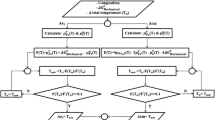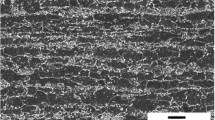Abstract
Nowadays, the application of kinetics models for predicting microstructures of steels subjected to thermo-mechanical treatments has increased to minimize direct experimentation, which is costly and time consuming. In the current work, the final microstructures of AISI 4140 steel sheets after the hot stamping process were predicted using the Kirkaldy and Li kinetics models combined with new thermodynamically based models in order for the determination of the appropriate process temperatures. In this way, the effect of deformation during hot stamping on the Ae3, Acm, and Ae1 temperatures was considered, and then the equilibrium volume fractions of phases at different temperatures were calculated. Moreover, the ferrite transformation rate equations of the Kirkaldy and Li models were modified by a term proposed by Åkerström to consider the influence of plastic deformation. Results showed that the modified Kirkaldy model is satisfactory for the determination of appropriate austenitization temperatures for the hot stamping process of AISI 4140 steel sheets because of agreeable microstructure predictions in comparison with the experimental observations.


















Similar content being viewed by others
Notes
In fact, the thermal history of the specimens was validated using the strategy in which the heat transfer coefficient of AISI 4140 steel and water was determined by trial and error in simulations so that the obtained cooling rates resulted in satisfactory hardness predictions of the Creusot-Loire equations comparing with the empirical results. Therefore, it can be declared that the averaged heat transfer coefficient obtained by this method (200 W/m2 K) acts in the similar way that the heat transfer coefficient changes with temperature and the latent heat of transformations are considered in simulations.
Abbreviations
- m :
-
A material coefficient
- p :
-
A material coefficient
- t :
-
Time (s)
- G :
-
The prior austenite grain size
- T :
-
The absolute temperature (K)
- Xn:
-
The normalized transformed austenite volume fraction
- Acm:
-
The start equilibrium temperature of the cementite transformation (K)
- Ae3 :
-
The start equilibrium temperature of the ferrite transformation (K)
- Ae1 :
-
The start equilibrium temperature of the pearlite transformation (K)
- B s :
-
The start temperature of the bainite transformation (K)
- B nose :
-
The temperature below Ae1 at which the ferrite volume fraction reaches zero (K)
- M s :
-
The start temperature of the martensite transformation (K)
- C i :
-
The weight percentage of the element i
- R :
-
The universal gas constant (J/mol K)
- \( \bar{\varepsilon }_{\rm{a}}^{\rm{P}} \) :
-
The effective plastic strain in austenite
- μ j i :
-
The chemical potential of the component i in the phase j (J/mol)
- ΔG γMechanical :
-
The molar mechanical energy stored in austenite (J/mol)
- σ :
-
The equivalent stress (Pa)
- ɛ P :
-
The equivalent plastic strain
- ρ s :
-
The density (kg/m3)
- M :
-
The molar mass (kg/mol)
- X F :
-
The volume fraction of ferrite
- X P :
-
The volume fraction of pearlite
- X B :
-
The volume fraction of bainite
- X M :
-
The volume fraction of martensite
- C F :
-
The equilibrium weight fraction of ferrite
- C αγ :
-
The weight percentage of carbon in the gamma phase in equilibrium with the alpha phase
- C γα :
-
The weight percentage of carbon in the alpha phase in equilibrium with the gamma phase
- C cemγ :
-
The weight percentage of carbon in the austenite phase in equilibrium with the cementite phase
- C cemα :
-
The weight percentage of carbon in the alpha phase in equilibrium with the cementite phase
- ρ A :
-
The density of austenite (kg/m3)
- ρ F :
-
The density of ferrite (kg/m3)
- ρ P :
-
The density of pearlite (kg/m3)
- ρ B :
-
The density of bainite (kg/m3)
- \( \Delta t \) :
-
The time increment (s)
- XnF(T):
-
The normalized ferrite volume fraction at the beginning of the time step of the temperature T
- XnP(T):
-
The normalized pearlite volume fraction at the beginning of the time step of the temperature T
- XnB(T):
-
The normalized bainite volume fraction at the beginning of the time step of the temperature T
- XeF(T):
-
The equilibrium (max) ferrite volume fraction at the temperature T
- XeP(T):
-
The equilibrium (max) pearlite volume fraction at the temperature T
- XeB(T):
-
The equilibrium (max) bainite volume fraction at the temperature T
- XnF′(T):
-
The normalized ferrite volume fraction at the end of the time step of the temperature T
- XnP′(T):
-
The normalized pearlite volume fraction at the end of the time step of the temperature T
- XnB′(T):
-
The normalized bainite volume fraction at the end of the time step of the temperature T
- \( \Delta t_{{1\%X_{\text{F}} }} \) :
-
The time period between the austenite transformation start and formation of one volume percent of ferrite (s)
- \( \Delta t_{{1\%X_{\text{P}} }} \) :
-
The time period between the austenite transformation start and formation of one volume percent of pearlite (s)
- \( \Delta t_{{1\%X_{\text{B}} }} \) :
-
The time period between the austenite transformation start and formation of one volume percent of bainite (s)
- \( T_{{1\%X_{\text{F}} }} \) :
-
The temperature of the formation of one volume percent of ferrite (K)
- \( T_{{1\%X_{\text{P}} }} \) :
-
The temperature of the formation of one volume percent of pearlite (K)
- \( T_{{1\%X_{\text{B}} }} \) :
-
The temperature of the formation of one volume percent of bainite (K)
- Δt total :
-
The time period between the austenite transformation start and finish (s)
- T finish :
-
The temperature of the end of the austenite transformation (K)
- HVFP:
-
The hardness of ferrite + pearlite (Vickers)
- HVB:
-
The hardness of bainite (Vickers)
- HVM:
-
The hardness of martensite (Vickers)
- HVN:
-
The total hardness (Vickers)
- Vr:
-
The cooling rate at 700 °C (°C/s)
References
H. Karbasian and A.E. Tekkaya, A Review on Hot Stamping, J. Mater. Process. Technol., 2010, 210, p 2103–2118
H.S. Liu, Z.W. Xing, J. Bao, and B.Y. Song, Investigation of the Hot-Stamping Process for Advanced High-Strength Steel Sheet by Numerical Simulation, J. Mater. Eng. Perform., 2010, 19, p 325–334
P. Åkerström, “Modelling and Simulation of Hot Stamping”, Ph.D. Thesis, Luleå University of Technology, 2006
M. Naderi, “Hot stamping of Ultra High Strength Steels”, Ph.D. Thesis, RWTH Aachen University, 2007
M. Naderi, V. Uthaisangsuk, U. Prahl, and W. Bleck, A Numerical and Experimental Investigation into Hot Stamping of Boron Alloyed Heat Treated Steels, Steel Res. Int., 2008, 79, p 77–84
P. Samadian, M.H. Parsa, and A. Shakeri, Determination of Proper Austenitization Temperatures for Hot Stamping of AISI, 4140 Steel, J. Mater. Eng. Perform., 2014, 23, p 1138–1145
M. Naderi, M. Ketabchi, M. Abbasi, and W. Bleck, Analysis of Microstructure and Mechanical Properties of Different High Strength Carbon Steels After Hot Stamping, J. Mater. Process. Technol., 2011, 211, p 1117–1125
P. Samadian, A. Shakeri, M.H. Parsa, Prediction of Microstructure after Hot Stamping Process on 4140 Steel Sheet, December 27–29, 3rd International Conference on Manufacturing Engineering ICME2011, Tehran, Iran, 2011
S. Serajzadeh, Modelling of Temperature History and Phase Transformations During Cooling of Steel, J. Mater. Process. Technol., 2004, 146, p 311–317
T.Y. Hsu, Additivity Hypothesis and Effects of Stress on Phase Transformations in Steel, Curr. Opin. Solid State Mater. Sci., 2005, 9, p 256–268
J. Chipalkatti, “Modeling of Austenite Decomposition in an AISI 4140 Steel”, Master of Science Thesis, University of British Columbia, 1999
H.H. Bok, M.G. Lee, E.J. Pavlina, F. Barlat, and H.D. Kim, Comparative Study of the Prediction of Microstructure and Mechanical Properties for a Hot-Stamped B-Pillar Reinforcing Part, Int. J. Mech. Sci., 2011, 53, p 744–752
J.S. Kirkaldy, D. Venugopalan, Prediction of Microstructure and Hardenability in Low Alloy Steels, International Conference on Phase Transformations in Ferrous Alloys, A.R. Marder and J.I Goldstein, Ed., Philadelphia, USA, 1983, p 125–148
M.V. Li, D.V. Niebuhr, L.L. Meekisho, and D.G. Atteridge, A Computational Model for the Prediction of Steel Hardenability, Metal. Mater. Trans. B, 1998, 29B, p 661–672
P. Samadian, M.H. Parsa, M. Nili Ahmadabadi, and H. Mirzadeh, Prediction of Temperatures of Austenite Equilibrium Transformations in Steels during Thermomechanical Processing, J. Mater. Eng. Perform., 2014, 23, p 3710–3717
N. Xiao, M. Tong, Y. Lan, D. Li, and Y. Li, Coupled Simulation of the Influence of Austenite Deformation on the Subsequent Isothermal Austenite-Ferrite Transformation, Acta Mater., 2006, 54, p 1265–1278
J.J. Jonas, V.V. Basabe, and C. Ghosh, Transformation of Deformed Austenite at Temperatures Above the Ae3, Mater. Sci. Forum, 2012, 706–709, p 49–54
C. Ghosh, V.V. Basabe, J.J. Jonas, Y.M. Kim, I.H. Jung, and S. Yue, The Dynamic Transformation of Deformed Austenite at Temperatures Above the Ae3, Acta Mater., 2013, 61, p 2348–2362
J.S. Ye, H.B. Chang, and T.Y. Hsu, A Kinetics Model of Isothermal Ferrite and Pearlite Transformations Under Applied Stress, ISIJ Int., 2004, 44, p 1079–1085
D. Bombac, M.J. Peet, S. Zenitani, S. Kimura, T. Kurimura, H.K.D.H. Bhadeshia, An Integrated Hot-Rolling and Microstructure Model for Dual-Phase Steels, Modell. Simul. Mater. Sci. Eng., 22, 2014
C. Ghosh, V.V. Basabe, and J.J. Jonas, Thermodynamics of Dynamic Transformation of Hot Deformed Austenite in Four Steels of Increasing Carbon Contents, Mater. Sci. Eng. A, 2014, 591, p 173–182
M.-C. Zhao, K. Yang, F.-R. Xiao, and Y.-Y. Shan, Continuous Cooling Transformation of Undeformed and Deformed Low Carbon Pipeline Steels, Mater. Sci. Eng. A, 2003, 355, p 126–136
N. Isasti, D. Jorge-Badiola, M.L. Taheri, B. López, and P. Uranga, Effect of Composition and Deformation on Coarse-Grained Austenite Transformation in Nb-Mo Microalloyed Steels, Metall. Mater. Trans. A, 2011, 42, p 3729–3742
A. Barcelona and D. Palmeri, Effect of Plastic Hot Deformation on the Hardness and Continuous Cooling Transformations of 22MnB5 Microalloyed Boron Steel, Metall. Mater. Trans. A, 2009, 40A, p 1160–1174
T. Inoue and Z. Wang, Coupling between stress, temperature, and metallic structures during processes involving phase transformations, Mater. Sci. Technol., 1985, 1, p 845–850
S. Denis, E. Gautier, A. Simon, and G. Beck, Stress-phase transformation interactions—basic principles, modelling and calculation of internal stresses, Mater. Sci. Technol., 1985, 1, p 805–814
Abaqus/Explicit: User’s Examples and Theory Manuals. Dassault Systèmes, 2007
K. Hashiguchi, J.S. Kirkaldy, T. Fukuzumi, and V. Pavaskar, Prediction of the Equilibrium, Paraequilibrium and No Partition Local Equilibrium Phase Diagrams for Multicomponent Fe-C Base Alloys, CALPHAD, 1984, 8, p 173–186
D.V. Doane and J.S. Kirkaldy, Hardenability Concepts with Applications to Steel, 1st ed., AIME, Warrendale, 1978
J.S. Kirkaldy and E.A. Baganis, Thermodynamic Prediction of the Ae3 Temperature of Steels with additions Mn, Si, Ni, Cr, Mo, Cu, Metall. Trans. A, 1978, 9A, p 495–501
K.O. Lee, A Study on the Mechanical Properties for Developing a Computer Simulation Model for Heat Treatment Process, J. Mater. Process. Technol., 2007, 182, p 65–72
L.C.F. Canale, G.S. Sarmiento, G.E. Totten, and R.N. Penha, Effect of vegetable oil oxidation on the ability to harden AISI 4140 steel, 60º Congresso Anual da ABM-Internacional, 25–28 July, Belo Horizonte, MG, Brazil, 2005
S.I. Kim, Y. Lee, and S.M. Byon, Study on Constitutive Relation of AISI, 4140 Steel Subject to Large Strain at Elevated Temperatures, J. Mater. Process. Technol., 2003, 140, p 84–89
P.J. Moroz, The effects of carbon content, matrix hardness and microstructure on the wear of steel grinding balls during wet copper and ore grinding, 9th District 6 Meeting, 24–27 Oct., Kamloops, 1984
Author information
Authors and Affiliations
Corresponding author
Rights and permissions
About this article
Cite this article
Samadian, P., Parsa, M.H. & Mirzadeh, H. Prediction of Proper Temperatures for the Hot Stamping Process Based on the Kinetics Models. J. of Materi Eng and Perform 24, 572–585 (2015). https://doi.org/10.1007/s11665-014-1371-3
Received:
Revised:
Published:
Issue Date:
DOI: https://doi.org/10.1007/s11665-014-1371-3




